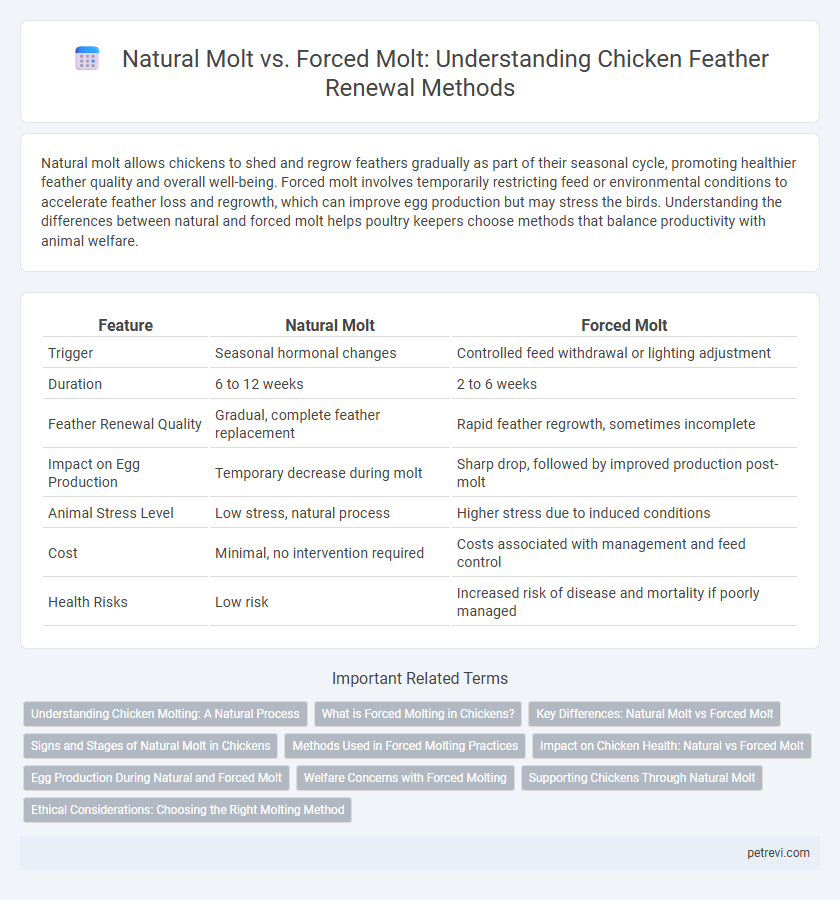Natural molt allows chickens to shed and regrow feathers gradually as part of their seasonal cycle, promoting healthier feather quality and overall well-being. Forced molt involves temporarily restricting feed or environmental conditions to accelerate feather loss and regrowth, which can improve egg production but may stress the birds. Understanding the differences between natural and forced molt helps poultry keepers choose methods that balance productivity with animal welfare.
Table of Comparison
| Feature | Natural Molt | Forced Molt |
|---|---|---|
| Trigger | Seasonal hormonal changes | Controlled feed withdrawal or lighting adjustment |
| Duration | 6 to 12 weeks | 2 to 6 weeks |
| Feather Renewal Quality | Gradual, complete feather replacement | Rapid feather regrowth, sometimes incomplete |
| Impact on Egg Production | Temporary decrease during molt | Sharp drop, followed by improved production post-molt |
| Animal Stress Level | Low stress, natural process | Higher stress due to induced conditions |
| Cost | Minimal, no intervention required | Costs associated with management and feed control |
| Health Risks | Low risk | Increased risk of disease and mortality if poorly managed |
Understanding Chicken Molting: A Natural Process
Chicken molting is a natural physiological process during which hens shed old feathers and grow new ones, typically occurring annually to restore plumage quality and support egg production. Natural molt is triggered by changes in daylight and nutrition, allowing chickens to gradually renew feathers with minimal stress. Forced molt, in contrast, is an induced method using dietary restriction or environmental manipulation to accelerate feather renewal and temporarily halt egg laying.
What is Forced Molting in Chickens?
Forced molting in chickens is an artificial technique used by poultry producers to induce a rapid cessation of egg production, allowing the hens to shed old feathers and regrow new ones more quickly. This process typically involves controlled feed restriction, water limitation, or environmental stressors to mimic natural molting conditions. The practice aims to rejuvenate the reproductive system, improve eggshell quality, and extend the productive lifespan of laying hens.
Key Differences: Natural Molt vs Forced Molt
Natural molt in chickens occurs gradually as part of their yearly biological cycle, allowing feathers to renew without significant stress, whereas forced molt is an induced process often triggered by manipulating light, feed, or water to accelerate feather loss and regrowth. Natural molting supports steady egg production and overall health, while forced molting temporarily halts laying to rejuvenate the bird's reproductive system for improved future productivity. The key difference lies in the method and impact: natural molt is spontaneous and less intrusive, whereas forced molt is a controlled, intensive management practice designed for commercial efficiency.
Signs and Stages of Natural Molt in Chickens
Natural molt in chickens involves a gradual, seasonal feather loss typically occurring annually, signaling the bird's transition into a rest phase for feather regeneration. Early signs include duller plumage, decreased egg production, and scattered feather shedding, followed by a complete renewal phase where new feathers emerge in distinct feather tracts. This biological process supports the bird's overall health and productivity by enabling efficient feather replacement without the stress associated with forced molt techniques.
Methods Used in Forced Molting Practices
Forced molting in chickens commonly employs methods such as feed restriction, water withdrawal, or altered lighting schedules to induce rapid feather renewal and rejuvenate egg production. These practices significantly reduce nutrient intake, triggering physiological stress that restarts the molting cycle within a controlled timeframe. While effective in commercial poultry management, forced molting requires careful monitoring to minimize animal welfare concerns and ensure optimal recovery post-molt.
Impact on Chicken Health: Natural vs Forced Molt
Natural molt allows chickens to renew feathers gradually, supporting better immune function and reduced stress hormone levels, which enhances overall health. Forced molt, often induced by feed restriction or lighting manipulation, can lead to short-term health risks such as increased susceptibility to disease, weakened immune response, and elevated corticosterone levels. Studies show natural molting promotes longevity and sustained productivity, while forced molting may compromise bird welfare despite accelerating feather regrowth.
Egg Production During Natural and Forced Molt
Natural molt in chickens typically causes a gradual decline in egg production as birds shed old feathers and grow new ones, allowing them to maintain moderate laying rates during this period. Forced molt, induced through nutritional or environmental stress, leads to a more rapid cessation of egg production, accelerating ovarian regression and improving post-molt egg quality and quantity. Egg production resumes more quickly and robustly after forced molt compared to natural molt, making it a preferred method in commercial poultry operations.
Welfare Concerns with Forced Molting
Forced molting in chickens involves inducing stress through feed restriction or environmental changes, leading to concerns about animal welfare due to increased hunger, dehydration, and vulnerability to disease. Natural molting allows chickens to shed and regrow feathers gradually without artificial stressors, promoting better overall health and immune function. Scientific studies emphasize that welfare-friendly practices during feather renewal improve productivity and reduce mortality rates in poultry operations.
Supporting Chickens Through Natural Molt
Supporting chickens through natural molt enhances feather renewal by allowing hens to gradually shed and regrow feathers without the stress associated with forced molting methods. Providing a balanced diet rich in protein, vitamins, and minerals helps maintain hen health and promotes efficient feather regrowth during the natural molt process. Ensuring a comfortable, low-stress environment with ample space and clean water supports overall well-being and accelerates recovery in natural molting chickens.
Ethical Considerations: Choosing the Right Molting Method
Natural molt allows chickens to renew feathers through their inherent biological cycle, promoting animal welfare by minimizing stress and health risks. Forced molt, often induced by controlled feed or light restriction, raises ethical concerns due to potential adverse effects on bird well-being and immune function. Prioritizing natural molt supports ethical poultry management by aligning with humane treatment principles and enhancing long-term flock health.
Natural Molt vs Forced Molt for Chicken Feather Renewal Infographic

 petrevi.com
petrevi.com